Key takeaways:
- Independent play fosters creativity, problem-solving skills, and emotional management in children.
- Creating a safe environment and choosing age-appropriate toys are essential for encouraging independent play.
- Establishing playtime routines and involving children in planning enhances their confidence and ownership of their play experiences.
- Encouraging problem-solving through open-ended activities builds resilience and emphasizes the value of persistence over immediate success.
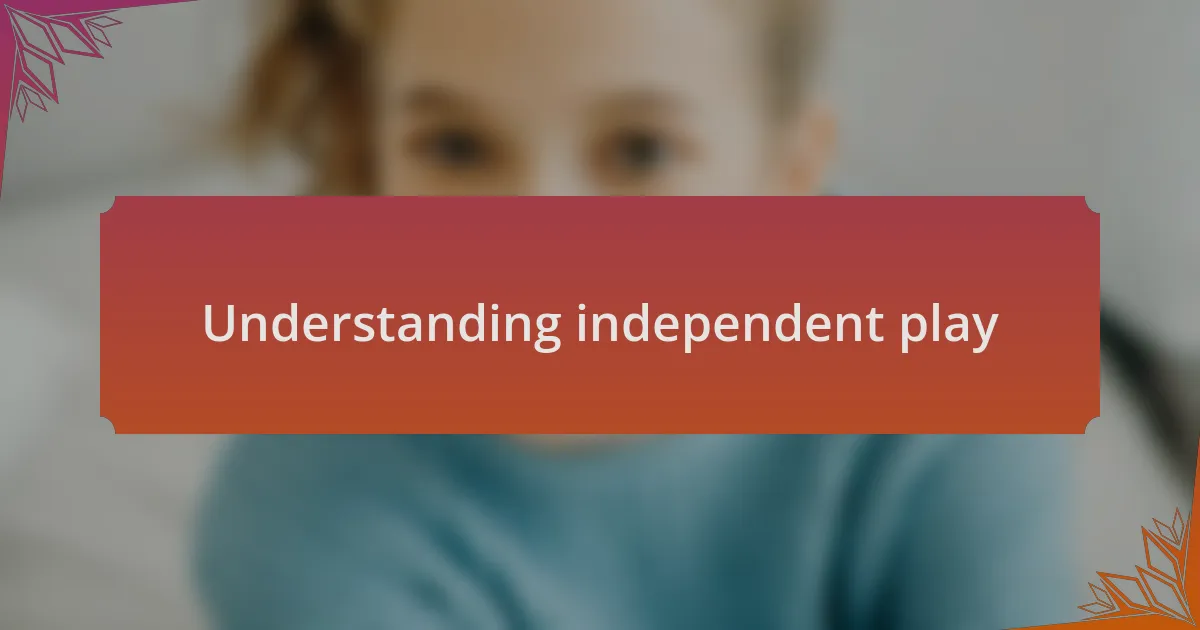
Understanding independent play
Independent play is a crucial aspect of childhood development, fostering creativity and problem-solving skills. I remember when my child first discovered the joy of building a fort from cushions—it was a simple act, yet it ignited hours of imaginative play. In those moments, I often wondered how much I had been stifling her creativity by always suggesting activities instead of letting her explore on her own.
Engaging in independent play not only boosts a child’s confidence but also helps them learn to manage their emotions. I’ve seen my child’s mood shift dramatically when she spends time playing alone; those moments of solitude seem to offer her a kind of introspection that group play doesn’t. Have you ever noticed how children can lose themselves in an activity? It’s almost like watching a little artist at work, forming an intricate world that reflects their thoughts and feelings.
Furthermore, fostering independent play can be a balancing act for parents. It can be uncomfortable to step back and let them figure things out, especially when you’re wired to protect them. I’ve found that giving my child the space to navigate her challenges, whether she’s figuring out how to balance a block tower or deciding how to resolve a pretend conflict with her toys, has been incredibly rewarding. Isn’t it fascinating how, through these experiences, children learn resilience and autonomy?
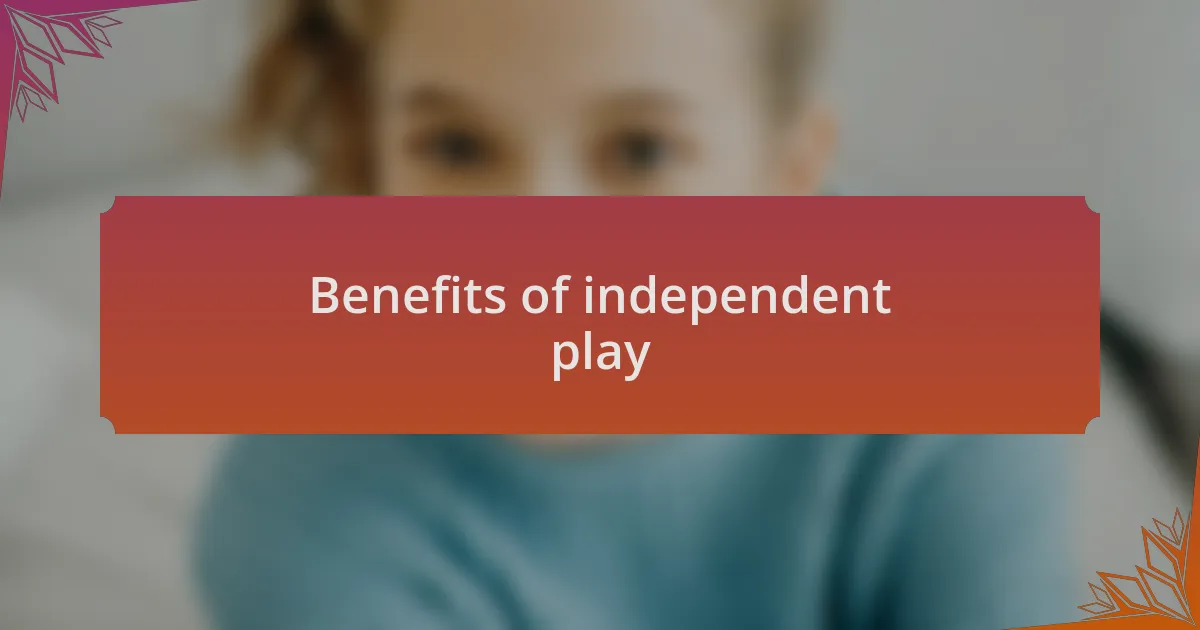
Benefits of independent play
One of the most profound benefits I’ve observed from independent play is the development of critical thinking skills. I recall my child engrossed in a puzzle one rainy afternoon. She struggled at first, but as she turned pieces over and examined them, I was struck by her determination. Watching her piece together the puzzles, it hit me: this was more than just play; it was a powerful exercise in logic and reasoning. Isn’t it amazing how children can solve problems when given the chance?
Moreover, independent play cultivates a sense of self-reliance that is crucial as kids grow. I’ll never forget the day my daughter decided to prepare a pretend dinner for her dolls. She didn’t ask for my help, but went into the kitchen, gathered ingredients from her toy set, and plated them with such flair. That moment sparked a realization in me about her budding independence. How could I have doubted her ability to create her own adventures?
Finally, independent play can be a fantastic opportunity for parents to catch their breath. It’s easy to feel overwhelmed by the constant demands of parenthood. When I encourage my child to engage in solitary play, I find a moment of peace in the chaos. It’s not just beneficial for her; it reminds me how essential it is to respect our own need for reflection and recharge as parents. Have you felt that same relief when you allow your child the space to play on their own? It’s a win-win for both sides.
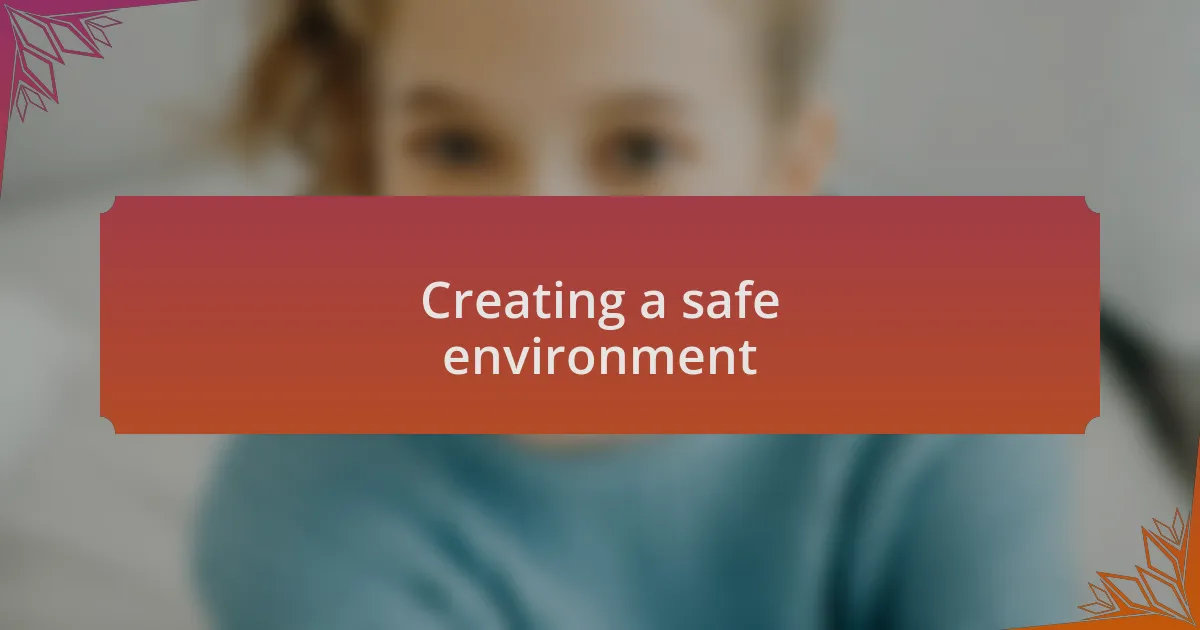
Creating a safe environment
Creating a safe environment is fundamental to encouraging independent play. I remember the first time I set up a small “exploration zone” in our living room, complete with soft cushions and engaging toys. I felt a wave of relief when I saw my child confidently diving into her imaginative world, knowing that she was safe and free to experiment without any worries. Isn’t it comforting to see our kids thrive in a space where they can roam and explore at their own pace?
One aspect I always prioritize is ensuring that play areas are free from hazards. I can’t tell you how much peace of mind I get from having outlets covered, sharp objects out of reach, and choking hazards removed. The first time my little one tripped and fell, I was anxious. But knowing the area was safe calmed my fears. It allowed her to get right back up and continue playing, which is essential for her confidence. Isn’t it empowering to know we can create spaces where our children can learn from their experiences, even the stumbles?
Additionally, I’ve found that establishing clear boundaries helps children understand what is safe and what isn’t. I often share stories with my child about why certain areas or items are off-limits. Just the other day, we had a chat about why the kitchen can be tricky. I noticed her eyes widened with understanding. How amazing is it when we can turn a conversation into a lesson that empowers rather than restricts? Creating a safe environment is not just about physical protection; it’s about nurturing their curiosity within a framework of care and guidance.

Choosing appropriate toys
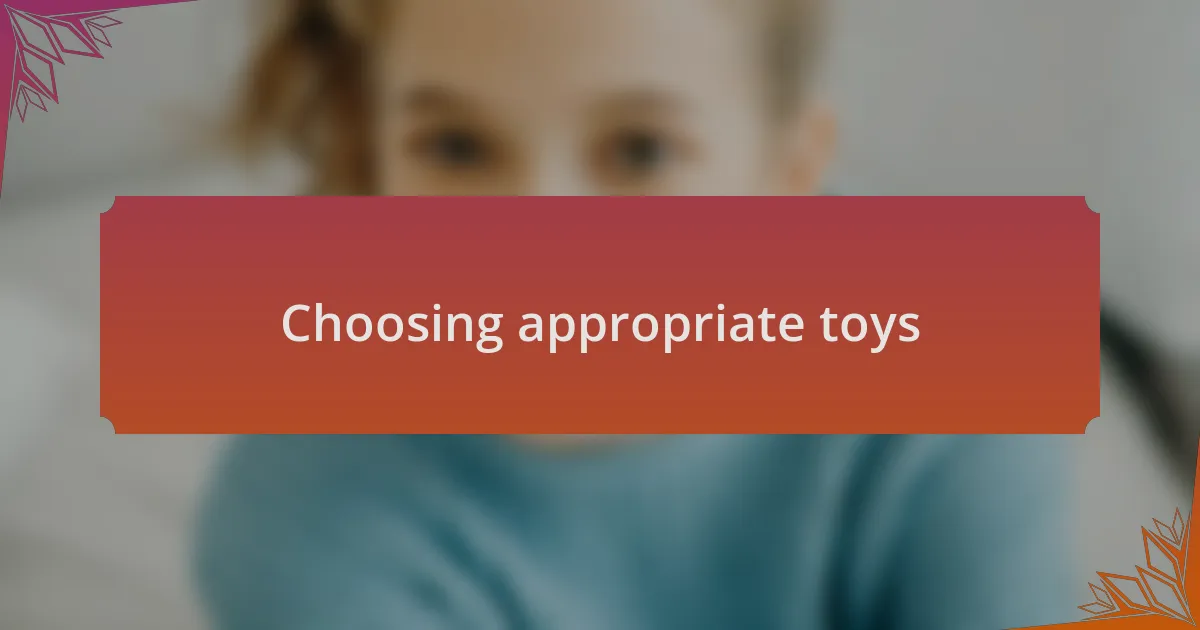
Choosing appropriate toys
When it comes to selecting toys, I always aim for those that spark creativity. I recall the day I brought home a simple set of blocks. It amazed me to see how my child transformed them into everything from a castle to a spaceship, all while narrating an elaborate story. Isn’t it incredible how the simplest toys can unleash such a wealth of imagination?
I also pay attention to age-appropriate toys. The first time I bought a toy that was too advanced for my little one, I saw her frustration as she struggled to figure it out. It hit me then that toys should not only entertain but also be manageable. This experience taught me the importance of ensuring that toys match my child’s developmental stage. After all, the right toy can foster confidence and a sense of accomplishment.
Lastly, I believe in choosing toys that promote problem-solving skills. One afternoon, I introduced a puzzle to my child, and I watched her tackle it piece by piece. The look of sheer determination on her face was priceless. Isn’t it rewarding when children engage with something that not only challenges them but also strengthens their cognitive abilities? The right toys can make the world of difference in supporting independent play while nurturing essential skills along the way.
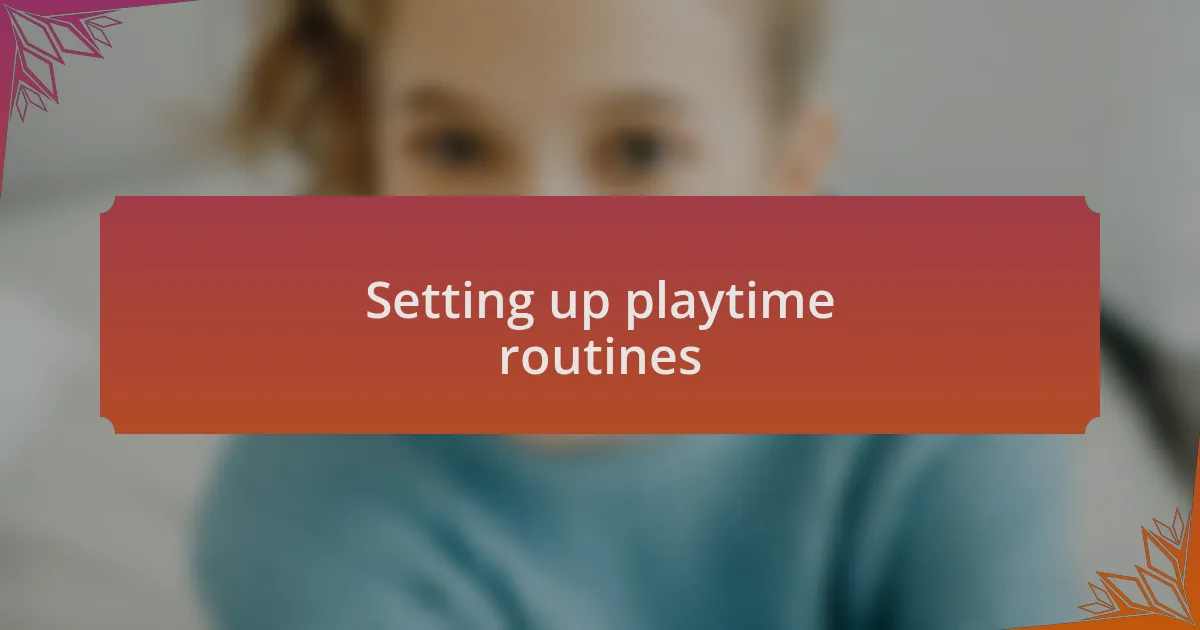
Setting up playtime routines
Establishing playtime routines has been pivotal in nurturing my child’s ability to engage in independent play. I remember a time when I decided to carve out a consistent playtime in our daily schedule. At first, it felt like just another task, but I soon discovered that this small commitment created a sense of security for my child. Having a specific time set aside for play helped her understand that it was her moment to explore and be creative without interruption.
I also found it helpful to create a calm environment before playtime. For instance, I started dimming the lights and playing soft music to signal that it was time to transition into play mode. It’s fascinating how these small adjustments can enhance focus and spark excitement. What I learned is that children thrive on structure while also appreciating the freedom to explore within that framework.
One thing I’ve noticed is the importance of involving my child in these routines. I often ask her what activities she’d like to include in our playtime, letting her take ownership. This not only empowers her to make choices but also increases her eagerness to engage independently. Isn’t it amazing how the act of simply asking for input can foster independence and confidence in a child?
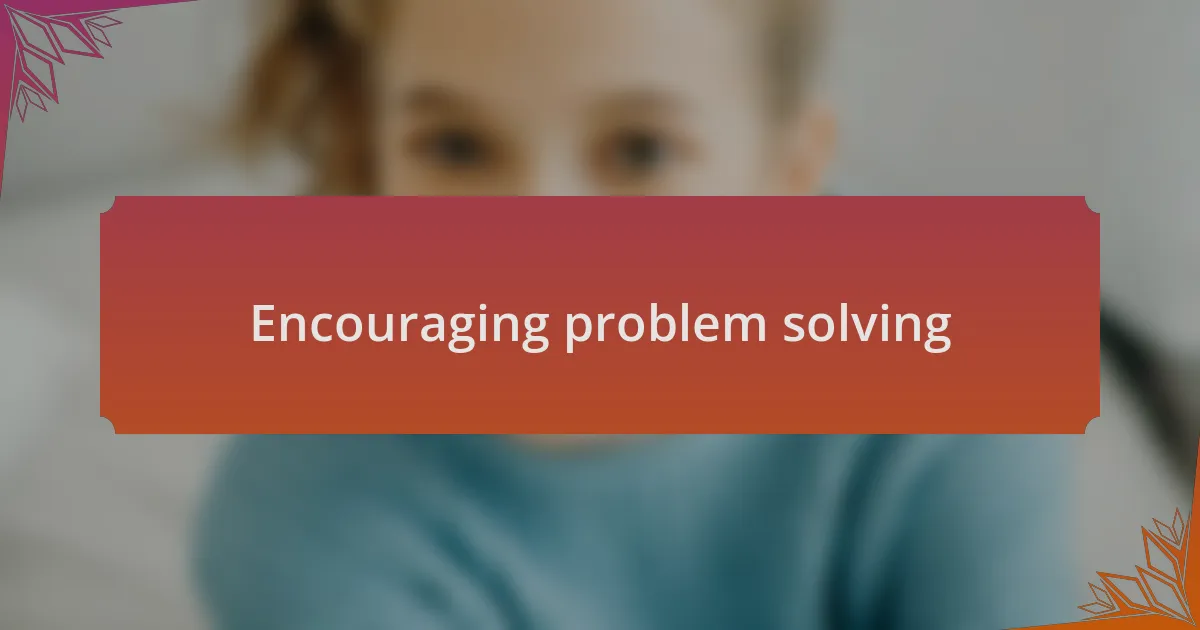
Encouraging problem solving
When it comes to fostering problem-solving skills during playtime, I find that providing open-ended activities is crucial. One day, I set out a collection of blocks for my child without any specific instructions. Initially, she seemed unsure about how to begin, but as she started to stack and balance them, I could see her brain working through the challenge. Isn’t it rewarding to watch a child’s thought process unfold as they navigate obstacles?
I’ve noticed that when children encounter challenges, they often develop resilience. I vividly remember a rainy afternoon when my daughter struggled to figure out how to connect two puzzle pieces. Instead of stepping in right away, I offered a gentle prompt: “What do you think will happen if you flip that piece?” Her expression changed from frustration to determination, and eventually, her perseverance paid off. Moments like those remind me how vital it is to allow kids the space to work through their problems.
Encouraging problem solving isn’t just about the immediate challenges; it’s about celebrating the journey. I’ve made it a habit to praise the effort rather than just the outcome. When my child successfully figures something out, I often say, “I love how you didn’t give up!” This reinforces the idea that persistence is valued. How powerful is it for a child to recognize that their thought process and persistence matter more than a simple right or wrong answer?

Sharing my personal experiences
One of my favorite memories is when my son decided to build a fort in the living room using cushions and blankets. Rather than guiding him through the design, I simply took a step back, watching him unleash his creativity. I felt a mix of pride and nostalgia, remembering my own childhood fort-building adventures. Isn’t it incredible how something so simple can spark joy and innovation?
I recall a day when my daughter discovered a box of art supplies. Instead of presenting her with a structure to follow, I encouraged her to create freely. I sat nearby, doodling alongside her, and I will never forget the excitement in her eyes as she unveiled her masterpiece. It hit me then—how essential it is for children to express themselves through play, allowing their imaginations to flourish without restrictions. Don’t you think that fostering such self-expression is one of the greatest gifts we can give as parents?
Sometimes, I’ve noticed that my kids are more willing to engage in independent play when I share a bit of my own childhood experiences. I tell them about the hours I spent daydreaming in my backyard, crafting entire worlds from sticks and leaves. That connection, those shared stories, seem to inspire them to embark on their own adventures. Hasn’t your own past shaped how you guide your children in their exploration? I believe these moments of connection deepen their understanding that the possibilities are endless.